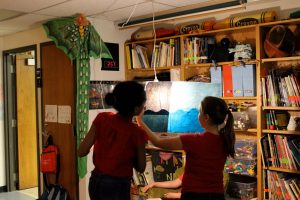
Experts across sectors are increasingly emphasizing the need for creativity. Creativity is identified as a key aspect of the future of work, a lynchpin of global competence, an important aspect of empathy, the basis of innovation, and a necessary ingredient to personal fulfillment. But what is creativity? What assumptions about creativity hold us back from nurturing it for ourselves and others? What habits characterize creative thinking, and what do they look like in learning?
The Columbus Museum of Art defines creativity as “the process of using imagination and critical thinking to generate new ideas that have value.” In other words, creativity involves seeing things as if they could be different, or envisioning things that do not yet exist. It also involves using analytical thinking to assume different perspectives, evaluate options, refine, and then bring a new idea into the world in some way. Creativity is deeply linked to empowerment, empathy, and fulfillment. Creativity is the basis of innovation in ways both large and small.
The product of the creative process is an idea manifested through anything from a painting to a mathematical proof. The impact could be as simple as a personal breakthrough in the way you approach your daily chores or as profound as a technological innovation that improves the delivery of medical care in remote areas.
Debunking Some Common Myths
Some commonly-held myths about creativity hinder our creative potential and inhibit the conditions in which creativity thrives.
One such myth of creativity is that of the “lone genius,” a larger-than-life individual working in an isolated studio to create a masterpiece or a breakthrough. This myth, deeply linked to attitudes about individualism, tells us that certain special people are creative and the rest of us are not. According to this myth, creativity is magical, unknowable, and inaccessible. You’re either born with it or you aren’t. “Creative types” pace around in solitude waiting for a lightning strike. **Include a note about the white, male, Western, elitism of our common examples?***
Creativity, though, is a practice we can all engage in by practicing imagination and critical thinking to come up with new ideas. Moreover, creative ideas are never the result of a single person working in a vacuum. As Edward Clapp puts it in his book Participatory Creativity, **** Collaboration – either directly or through the exchange of ideas over time – is always part of the creative process.
Many people think of creativity in artistic terms, and often think of themselves as un-creative because they have not developed skills in traditional art forms like drawing or music. Creativity, though, exists across domains.
At the Columbus Museum of Art, we value artists as models of creative and critical thinking. Artists can help us see the world in fresh ways, draw our attention to systems and conventions that we have ignored, propel us to new insights and questions, and create opportunities for us to engage deeply with what matters to us. Artists use their imaginations and critical thinking to create new ideas, manifested in works of art. By engaging deeply with those works we can build our own creative and critical thinking dispositions. Moreover, by studying the creative habits of artists, we can identify the habits, or dispositions, that characterize the creative process, and thereby more intentionally develop those dispositions for ourselves and learners.

Teachers at the CMA’s Teaching for Creativity Institute collaborating on a creativity challenge
Looking to artists as models of creative thinking, the CMA has created the evolving Thinking Like an Artist framework. This framework results from many years of research in learning environments, through literature on creativity and artistic practice, and in conversation with practicing artists. This research is ongoing, reflecting the learning inclination of
the CMA, and the framework is evolving. The Thinking Like an Artist framework currently comprises the following dispositions.The dispositions are listed below with a brief explanation of each. Click on Thinking Like an Artist for a more in-depth elaboration of each that explores more deeply what that disposition might look like in the classroom.
This framework is the basis of the Thinking Like an Artist Evolving Rubric for Educators Thinking Like an Artist Rubric.

